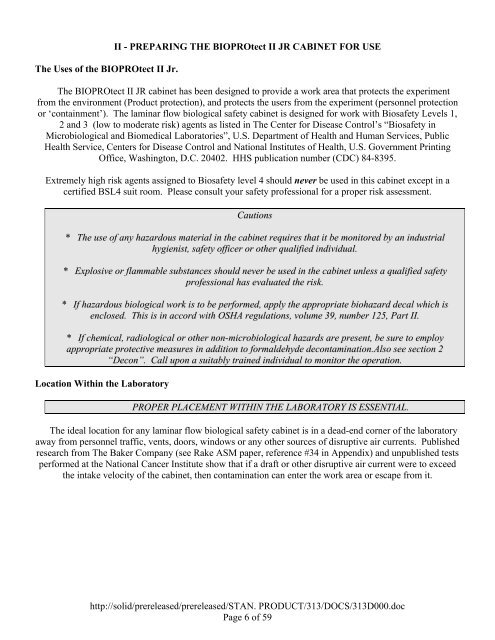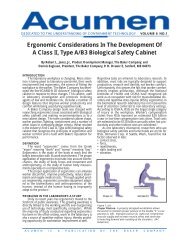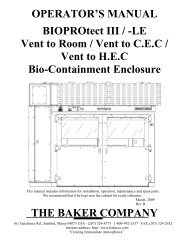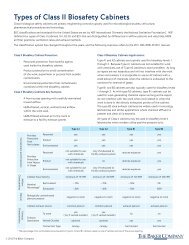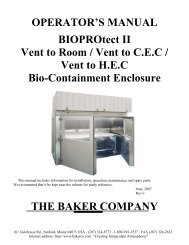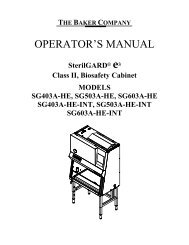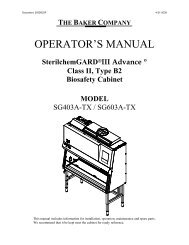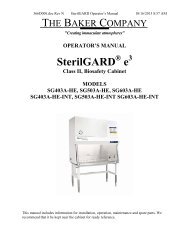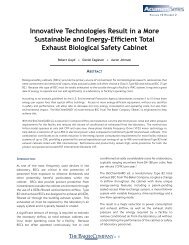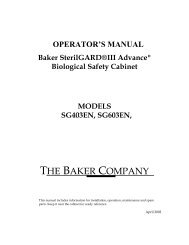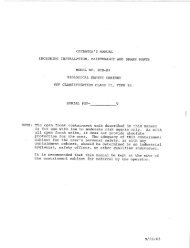OPERATOR'S MANUAL BIOPROtect II JR Vent to ... - Baker Company
OPERATOR'S MANUAL BIOPROtect II JR Vent to ... - Baker Company
OPERATOR'S MANUAL BIOPROtect II JR Vent to ... - Baker Company
Create successful ePaper yourself
Turn your PDF publications into a flip-book with our unique Google optimized e-Paper software.
The Uses of the <strong>BIOPROtect</strong> <strong>II</strong> Jr.<br />
<strong>II</strong> - PREPARING THE <strong>BIOPROtect</strong> <strong>II</strong> <strong>JR</strong> CABINET FOR USE<br />
The <strong>BIOPROtect</strong> <strong>II</strong> <strong>JR</strong> cabinet has been designed <strong>to</strong> provide a work area that protects the experiment<br />
from the environment (Product protection), and protects the users from the experiment (personnel protection<br />
or ‘containment’). The laminar flow biological safety cabinet is designed for work with Biosafety Levels 1,<br />
2 and 3 (low <strong>to</strong> moderate risk) agents as listed in The Center for Disease Control’s “Biosafety in<br />
Microbiological and Biomedical Labora<strong>to</strong>ries”, U.S. Department of Health and Human Services, Public<br />
Health Service, Centers for Disease Control and National Institutes of Health, U.S. Government Printing<br />
Office, Washing<strong>to</strong>n, D.C. 20402. HHS publication number (CDC) 84-8395.<br />
Extremely high risk agents assigned <strong>to</strong> Biosafety level 4 should never be used in this cabinet except in a<br />
certified BSL4 suit room. Please consult your safety professional for a proper risk assessment.<br />
Cautions<br />
* The use of any hazardous material in the cabinet requires that it be moni<strong>to</strong>red by an industrial<br />
hygienist, safety officer or other qualified individual.<br />
* Explosive or flammable substances should never be used in the cabinet unless a qualified safety<br />
professional has evaluated the risk.<br />
* If hazardous biological work is <strong>to</strong> be performed, apply the appropriate biohazard decal which is<br />
enclosed. This is in accord with OSHA regulations, volume 39, number 125, Part <strong>II</strong>.<br />
* If chemical, radiological or other non-microbiological hazards are present, be sure <strong>to</strong> employ<br />
appropriate protective measures in addition <strong>to</strong> formaldehyde decontamination.Also see section 2<br />
“Decon”. Call upon a suitably trained individual <strong>to</strong> moni<strong>to</strong>r the operation.<br />
Location Within the Labora<strong>to</strong>ry<br />
PROPER PLACEMENT WITHIN THE LABORATORY IS ESSENTIAL.<br />
The ideal location for any laminar flow biological safety cabinet is in a dead-end corner of the labora<strong>to</strong>ry<br />
away from personnel traffic, vents, doors, windows or any other sources of disruptive air currents. Published<br />
research from The <strong>Baker</strong> <strong>Company</strong> (see Rake ASM paper, reference #34 in Appendix) and unpublished tests<br />
performed at the National Cancer Institute show that if a draft or other disruptive air current were <strong>to</strong> exceed<br />
the intake velocity of the cabinet, then contamination can enter the work area or escape from it.<br />
http://solid/prereleased/prereleased/STAN. PRODUCT/313/DOCS/313D000.doc<br />
Page 6 of 59


